Weather Thermometers – What They Are And How They Work
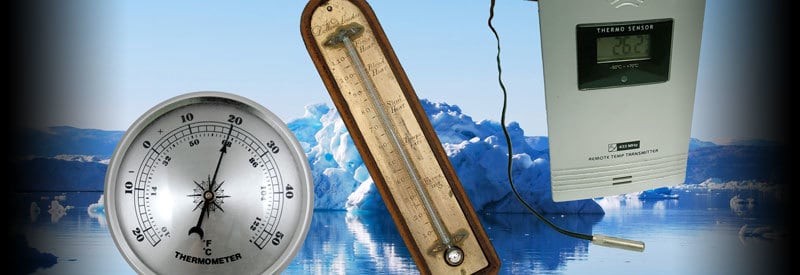
Most readers will be familiar with domestic or medical thermometers and how they measure temperature. Weather thermometers basically work on the same principles, but there are a few subtle differences.
A weather thermometer is defined as a meteorological instrument that measures and records the ambient air temperature at a given time. The most well-known thermometer is the mercury or liquid-in-glass thermometer. Bimetal thermometers and, more recently, digital thermometers are also widely used.
We get cold in the winter and warm in the summer and dress accordingly. You know the sensation of an ice-cold drink after spending time in hot weather. You also know the welcome relief of a warm beverage after having to spend some time in ice-cold weather.
So yes, we are all very aware of the temperature and how it influences every aspect of our daily life. After all, why do we spend every night or early morning listening or watching some form of weather forecast to prepare for the day?
But have you ever considered how temperature is measured in the first place? Did you know that there is actually more than just one form of temperature and a wide variety of different ways of measuring it?
The type of temperature we are focusing on in this article is air (ambient) temperature. More specifically, we will be looking at the different ways in which weather stations measure and collect ambient weather.
What Is Ambient Temperature?
Before going any further, let's first get a clear idea of what exactly ambient temperature is.
Just to avoid any misunderstanding, the temperature we are defining here is the temperature as it is observed and described in meteorological (weather) terms.

Ambient temperature can be defined as the average temperature of the air in your environment. Outdoor ambient temperature refers to the temperature of the air in the environment outside any confined spaces. (In other words, atmospheric air temperature.)
Indoor ambient temperature refers to the average air temperature within your home/office. (Referring to air temperature within confined spaces). Ambient temperature is NOT the actual temperature of any specific object or its surface temperature.
Depending on the field you study or work in, ambient temperature may have a few different meanings. It is very often used in the computing industry. Here ambient temperature refers to the air surrounding electronic components.
(The amount of heat generated by computer components is essential, as it can have a direct effect on the reliability and longevity of systems critical to our safety and everyday lives.)
A variety of different devices are used to measure ambient and other forms of temperature. To get a clear overall picture, we will first take a look at the broad spectrum of thermometers used to measure temperature in their respective fields.
We will then turn our attention to the instruments specifically designed to measure ambient (air) temperature.
The Different Types Of Thermometers And How They Measure Temperature
The instrument that is used to measure temperature is called a thermometer. Before delving into the different types of thermometers, one first needs to define exactly what a thermometer is.
Depending on their method of measurement or what type of temperature they measure, these devices may be called something completely different. However, in reality, they are all some form of a thermometer.
For the sake of getting a thorough overview of all the devices used in temperature measurement, it is necessary that we first take a brief look at the different thermometers used to measure all forms of temperature.
- Clinical Thermometers
- 2Glass / Mercury Thermometers
- 3Digital Thermometer
- 4Tympanic Thermometer
- 5Pacifier Thermometer
- 6Forehead Thermometer
- 7Laboratory Thermometers
- 8Food Thermometers
The best way to do this is to sort them under the main categories in which they will be used to measure a specific temperature:
Clinical Thermometers
Clinical thermometers are used to measure the temperature of the human body. It is, therefore, primarily used in the healthcare industry.
1) Glass/Mercury Thermometers
This is arguably the oldest and most trusted method of measuring temperature. It consists of a liquid (usually alcohol or mercury) that expands in a glass tube as the temperature increases.
The length to which it expands depends on the temperature. It is usually placed under the tongue or rectum (in the case of babies and animals.) After about 2 minutes, the thermometer is removed, and the temperature, as indicated on the glass tube, is measured.
Although replaced by digital thermometers in many cases, glass thermometers remains a reliable and accurate way of measuring temperature and are still used by many healthcare practitioners.
Glass/mercury thermometers are also widely used in the field of meteorology. Therefore we will take a more in-depth look at how this form of temperature measurement works later on in this article.
2) Digital Thermometer
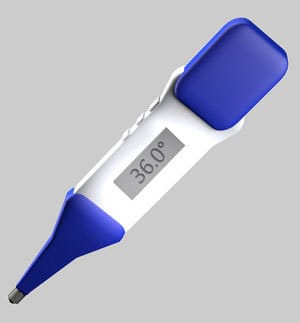
Unlike a glass/mercury thermometer, a digital thermometer needs an electrical power source (battery) to function. It uses the resistance created by a temperature-sensitive metal when an electrical current is passed through it to make a measurement.
(A resistance thermometer is the name given to a device using this form of measurement.)
The body's temperature is taken using the same methods as a mercury thermometer. The difference is that this device alerts you when it finishes measuring the temperature, and the result is shown on its digital display.
As resistance thermometers are also widely used to measure the weather, we will also take a much closer look at its inner workings later on in this post.
3) Tympanic (Ear) Thermometer
The eardrum and surrounding area are close to the brain and are an accurate way of determining your body temperature. It is a very sensitive organ, though, and can easily be damaged.
Therefore, extreme care should be taken to use any invasive form of device to measure the ear's temperature. The safest and most effective thermometer to use in this case uses infrared sensors to take a thermal reading in and around the eardrum remotely.
Medical professionals widely use an instrument called a thermopile for this very purpose. It makes use of infrared technology and is a safe way to measure the temperature of sensitive areas of the body like the eardrum.
4) Pacifier Thermometer
This type of thermometer is aimed for use in babies and toddlers, where other forms of measurements are challenging to perform.
It is basically a digital thermometer encased in the shape of a dummy. This allows the baby to suck on it, giving it enough time to take a reading.
Due to the amount of insulation and space between the actual thermometer and the body, pacifier thermometers are not very accurate. This makes them adequate for home use. Should any serious concerns arise, however, a physician should be contacted as soon as possible.
5) Forehead Thermometer
A forehead thermometer is an electronic handheld device using infrared technology to measure the temperature of a patient's forehead. It is arguably the least invasive way of taking the body's temperature.
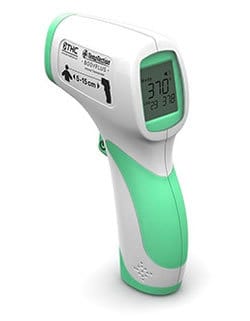
Also known as a temporal artery thermometer, the device is briefly placed against the temple area of the forehead where the temporal artery is located. After just a few seconds, the result is shown on a digital display.
(There is a "non-touch" version of the forehead thermometer where the device is simply aimed at the area of the forehead just above the eyebrows, and a measurement is taken.)
These devices have the advantage of being quick, accurate, and non-invasive. Compared to other thermometers, they are quite expensive, though.
Laboratory Thermometers
Laboratory (or scientific) thermometers are thermometers that are designed to measure temperature with a high degree of accuracy.
As the name suggests, they are used in controlled environments in various scientific laboratories and research facilities worldwide. It is due to the nature of their use that they need to be extremely accurate.
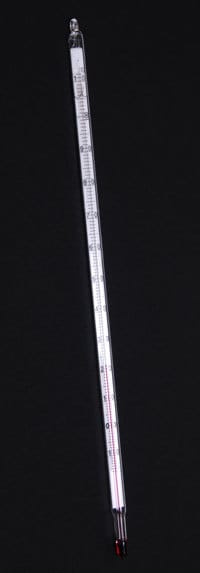
For example, they are often used in critical medical trials or the design of lightweight materials for the aviation and space industry. The smallest error in measurement can lead to fatal mistakes and material failure.
Another attribute that sets them apart from other thermometers is the ability to measure extreme temperatures. The different processes they are used in sometimes involve temperatures exceeding 1000° Celsius or dropping to well below freezing point.
The pyrometer is one such thermometer designed to measure extreme temperatures. It is a remote sensing device that measures the amount of thermal radiation of an object to determine its temperature. Its ability to measure thermal radiation from a distance allows it to calculate extreme temperatures without being anywhere near the object it is measuring.
Laboratories and research institutions use a variety of thermometers, many of which I already mentioned. This includes glass/mercury, infrared, and resistance thermometers.
Additional types of measuring technologies like bimetallic strip thermometers and thermocouples are also widely used in laboratories, and I will cover them in detail later on in this article.
Food Thermometers
As you've already seen in the previous sections, many different thermometers are used in a variety of fields. When it comes to food, it is pretty much the same story.
There are quite a number of categories food thermometers are organized in. Since we are starting to venture very far away from the main focus of this article, weather thermometers, I am going to keep this section brief and narrow it down substantially.
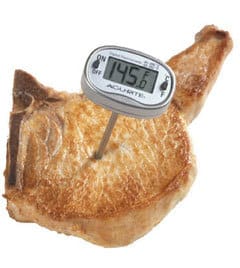
I created three general categories under which I feel most food thermometers can be listed. I then proceed to mention the most relevant thermometers used in each section quickly.
Since most of them use technologies also used in weather thermometers, I will just briefly name them without going into any description or explanation.
(We will be examining and describing the specific technologies in detail when we look at weather thermometers in the next section.)
Let's take a quick look at the different types of food thermometers.
1) Thermometers Safe To Leave In Food While Cooking
These thermometers are designed to be kept in the food while cooking to monitor the temperature throughout the whole process, whether inside or on top of the stove.
They are designed to withstand cooking temperatures for sustained periods.
These include dial oven-safe (bimetal) thermometers, disposable temperature indicators, oven probes with chords, and pop-up thermometers.
2) Thermometers For Use Use Before Or After Cooking
These thermometers are designed to measure food after cooking or when removed from the heat source for taking an interim measurement.
They are less robust than the thermometers designed to be kept in the food while cooking and are not intended to stay in the food throughout the whole cooking process.
These include digital instant-read (thermistor) thermometers, dial instant-read (bimetal) thermometers, thermometer-fork combination, and thermocouples.
All right, by now you will have a good idea of the vast number of thermometers and the different fields and industries in which we use them. They are even commonly used in the consumer and automotive industry. (Cars, motorcycles, refrigerators, and air-conditioners are just a few examples.)
This section focused on the different types of thermometers and their use, but the following section addresses this article's main subject: weather thermometers.
The Different Types Of Weather Thermometers And How They Work
The majority of different thermometers were already covered in the previous section. However, since the focus of this article is weather thermometers, we will examine each one in much more detail and explain the way they work.
What Is A Weather Thermometer?
A weather thermometer is a meteorological instrument that measures the ambient temperature of the air at any given time. The most well-known thermometer is the mercury or liquid-in-glass thermometer. Bimetal thermometers & more recently introduced digital thermometers are also widely used.
1) Mercury-In-Glass Thermometers
Mercury-in-glass thermometers are arguably the oldest and most widely recognized type of thermometer still used on a global scale today. It was invented by Daniel Gabriel Fahrenheit in 1714 in Amsterdam.

The thermometer consists of a glass bulb containing the mercury. A thin glass tube is attached to the top of the bulb.
The empty space in the thermometer is filled with nitrogen or some other gas with a pressure less than that of the normal atmospheric pressure. This allows space for the mercury to expand or contract within the tube.
As the temperature increases, the mercury starts to expand and push up in the narrow glass tube. Similarly, when the temperature decreases, the mercury contracts, and its level drops in the tube.
The glass tube has calibrated markings on it (or next to it), displaying the temperature in Fahrenheit or Celsius, depending on the system of measurement your country uses. (Sometimes both are indicated on or next to the tube.)
Advantages And Disadvantages Of A Mercury-In-Glass Thermometer
Like all other thermometers, mercury-in-glass thermometers also have their own strengths and weaknesses you should be aware of.
Advantages
- Mercury-in-glass thermometers are simple to use and read.
- They do not need any additional power source to operate.
- Mercury has a high boiling point.
- These thermometers are fairly inexpensive compared to other thermometers.
- They have a high degree of accuracy.
- Mercury-in-glass thermometers are durable and will last you for years.
Disadvantages
- Mercury is toxic and can cause pose a danger if the thermometer breaks.
- Mercury has a high freezing point, rendering them useless in extremely cold conditions.
- They cannot remotely transmit their data since no electronics are used in the device.
The alcohol-in-glass thermometer is a cheaper and less dangerous alternative to the mercury-in-glass thermometers. It works on exactly the same principle as the mercury-based device but has a few advantages.
First of all, it is not poisonous, and as a result, much safer to use than mercury. It is also much cheaper and has a lower freezing point, making it usable in extremely cold conditions.
On the flip-side, they are not as accurate as mercury-in-glass thermometers. They also have a lower boiling point, reducing their usability in very hot conditions.
I am a firm believer in the trusty mercury-in-glass thermometers. I also honestly believe any self-respecting weather professional or enthusiast should own at least one.
2) Bimetal Thermometer
Chances are pretty good you may have already seen a bimetal thermometer (sometimes referred to as a dial thermometer) at some point in your life.
Classic old dial thermometers were often neatly inserted into engraved wooden casings with an analog barometer installed above or below it and hanged against the wall.
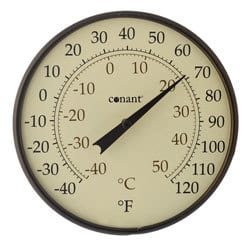
The technology is hardly new. It dates back as far as 1759, when it was developed by clockmaker John Harrison. It has withstood the test of time and is still used today.
This mainly due to its robustness and reliability, which makes it uniquely suited for use in the industrial and automotive environment. It is also still used in some dialed based thermometers to measure air temperature.
As the name suggests, a bimetal thermometer consists of two different strips of metals bonded together. Each metal responds differently to changes in temperature.
In a dial thermometer, the bimetal strip is in the shape of a coil, with one end fixed into place. The other end is connected to a measuring device like a needle.
As the ambient temperature changes around the metal strips, one of the metals will extend or contract in comparison with the other metal strip.
This contraction/extension will cause the needle (or any other form of indicator) to move on a calibrated scale, displaying the calculated air temperature.
Advantages And Disadvantages Of A Digital Thermometer (Thermistor)
The technology used in bimetal thermometers may be one of the oldest still used in modern times but is still very relevant today due to some specific advantages. It comes with its fair share of disadvantages, though.
Advantages
- Bimetal thermistors cover a wide range of temperature ranges.
- They are very robust and reliable.
- Due to their mechanical nature, these thermometers do not need an external power source.
- They have a simple working mechanism and are relatively inexpensive as a result.
Disadvantages
- Bimetal thermometers are not as accurate as many other modern weather thermometers.
- They need to be frequently calibrated to maintain an adequate amount of accuracy.
- Bimetal thermistors have a slow response to changes in temperature.
Bimetal thermometers are playing an almost insignificant role in modern-day meteorological instrumentation and measurement. Its significance and relevance should not be ignored, though, even today.
3) Digital Thermometer (Thermistor)
Digital weather thermometers use a component called a thermistor to measure and display ambient temperature and are used in a variety of digital devices, including weather stations.
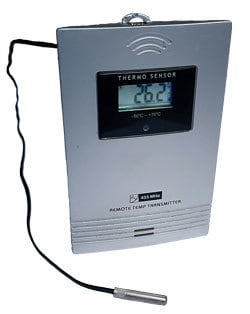
A thermistor is a specific type of resistor where the level of electrical resistance is dependent on the air temperature.
As the temperature change, the resistance in the thermistor changes. This causes a change in the strength of the electrical current flowing through the thermistor. By measuring the strength of the electrical current, the temperature can be calculated.
There are two types of thermistors, and a distinction should be made between them. They are the Negative Temperature Coefficient (NTC) and Positive Temperature Coefficient (PTC) thermistors and reacts in different ways when exposed to ambient temperature.
- Negative Temperature Coefficient (NTC) thermistors show a decrease in electrical resistance as the air temperature increases.
- Positive Temperature Coefficient (PTC) thermistors show an increase in electrical resistance as the air temperature increases.
Thermistors can measure temperatures from -90° Celsius (-130° Fahrenheit) to 130° Celsius (266° Fahrenheit). It is incredibly accurate within this temperature range, making it ideal for measuring the smallest change in ambient temperature.
The Three Types Of Digital Thermometers
There are actually three different types of digital thermometers that can be used in a weather station.
Due to their accuracy, quick response time, and affordability, thermistors are used in the vast majority of home and professional weather stations.
Just to get a quick overview, the three digital thermometers are:
1. Themistors:
The best choice for a weather station and already described in detail here.
2. RTD:
The Resistance Temperature Detector (RTD) works much like a thermistor by using the resistance in the RTD to measure temperature. Unlike a thermistor, it uses a pure metal, usually platinum, wrapped around a glass core. In most cases, the whole assembly is protected within a protective probe.
2. Thermocouples:
This type of thermometer uses two wires, each made of a different kind of metal. They are welded together to create a junction. It is at this junction where the temperature is measured. A change in temperature produces a voltage that is measured and converted into a temperature reading.
In theory, all three digital thermometers can be used in a weather stadium. Due to their nature and capabilities, thermistors are just generally the best choice for use in weather stations.
Resistance Temperature Detectors and Thermocouples are much more suited for use in the industrial and commercial industry, as well as in scientific research and testing facilities.
As the section above highlighted, a thermistor can be seen as a type of resistance thermometer (RTD), as it also uses the impact of changes in temperature on the resistance of a component to measure ambient temperature.
We must make a clear distinction between the difference between the two, though. First of all, even though the range of temperature that a thermistor can measure is more limited than that of an RTD, it can make much more accurate readings within this range.
Secondly, an RTD is made from pure metal like platinum (or sometimes substituted by copper or nickel). A thermistor, on the other hand, is made from semiconductor materials like polymer and ceramics.
Advantages And Disadvantages Of A Digital Thermometer (Thermistor)
I made a strong case for why the thermistor is the best type of digital thermometer for use in most meteorological applications. That does not mean it is not without its weaknesses.
Let's take a look at both its strengths and drawbacks.
Advantages
- The accuracy with which thermistors measure temperature overshadows that of other thermal sensors.
- It responds very quickly to changes in temperature, allowing it to display and make rapid adjustments.
- Their ability to make and record multiple measurements make them invaluable for use in remotely located weather stations.
- Thermistors are relatively inexpensive compared to other digital thermometers.
- Their compact size allows thermistors to be used inside a wide variety of components like outside weather sensors.
Disadvantages
- Thermistors do not have a broad temperature range as that of some other thermal sensors, making it unsuitable for some use some heavy industrial environments.
- The non-linear resistance-temperature characteristics of a thermistor can be a drawback.
- A thermistor requires a power source to operate. This requires maintenance on a more regular basis than a thermometer like a mercury-in-glass thermometer, which can operate completely maintenance-free.
- They are self-heating, which makes them prone to producing errors.
It is obvious why the thermistor plays such a big role as a weather thermometer, especially for use in home and professional weather stations.
We highlighted its many advantages in this section, and although it is not without its drawbacks, it is by far the digital thermometer of choice for use in measuring ambient temperature in weather stations.
There are other technologies used for measuring temperature, but are so rare and almost never used that there is no need to pay any attention to them in this article.
Now that we covered all weather thermometers in detail and you know how each one works, all that is left to do is to see which one is used in what type of weather station.
The Thermometers Used In Different Weather Stations
In the previous sections, we covered a wide variety of thermometers used in old and new weather stations. To stay relevant, though, we will now mainly focus on thermometers used in modern weather stations. (Even though "old technology" thermometers are still very popular and widely used in many modern weather stations.)
Let's first take a look at the thermometers commonly used in home weather stations before turning our attention to professional weather stations.
1) Home Weather Station Thermometers
Liquid-In-Glass Thermometers

Whether using mercury or alcohol, liquid-in-glass thermometers remain a firm favorite among weather enthusiasts. It is inexpensive and doesn't require an external power source to operate.
It is also very accurate and easy to install and read. Just hang it inside or outside your home in the optimum location, and you are all set.
(You also have the option of choosing a minimum-maximum thermometer, which allows the device to display both the minimum and maximum temperature of the environment over a given time.)
Digital Thermometers (Thermistors)
With the introduction and growth in popularity of digital home weather stations, the thermistor became the thermometer of choice in almost every single home weather station.
Like already mentioned, it is compact in size and very accurate. This makes it ideal to be placed in both indoor weather display consoles as well as outside sensor arrays.
The fact that it requires power to operate (which a digital home weather station already provides) also allows it to measure, record, and send multiple readings to a base station.
High-quality thermistors are used in the vast majority of high-end home weather stations. The Ambient WS-2902 I am using as my primary home station use thermistors for both the outdoor sensor array and the indoor base station.
To find out more about the Ambient WS-2902 and how a typical home weather station works, you can read the in-depth article here.
2) Professional Weather Station Thermometers
The type of instruments used in home and professional weather stations are pretty much based on the same technology and principles.
The real difference comes to the surface when we look at the accuracy and consistency with which measurements are taken.
Both of the above depends mostly on creating a stable environment for measuring ambient temperature, which brings us to one of the workhorses of professional meteorology.
The Stevenson Screen
Probably the most critical part of measuring the different elements of the weather is to create an environment where the most accurate measurement can be taken. This is where the Stevenson Screen comes in.
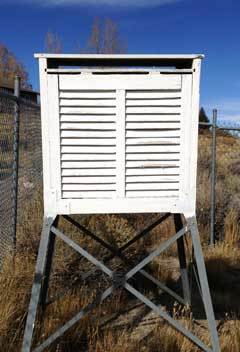
It is an enclosure of various sizes to house weather instrumentation. It protects the instruments from direct sunlight, rain, and solar radiation.
The Stevenson Screen is also painted white to reflect the heat from the sun and other sources of thermal radiation.
The sides of the housing have a double-louvered design. This protects the instruments from the elements while still allowing air to enter the enclosure.
The reason for this "open" design is to allow airflow through the enclosure to prevent any heat buildup inside the container. This allows the temperature to be the same as the outside air temperature in the shade.
Liquid-In-Glass Thermometers
Even with advances in technology, manned weather stations still make extensive use of analog glass thermometers.
When you open a Stevenson Screen at a professional weather observatory, don't be surprised to find more than one glass thermometer sitting alongside a thermistor or RTD.
They are not just a very accurate and reliable way of measuring temperature but can also be used as a backup and a criterion against which other readings can be measured.
Comparing the readings from all the different thermometers also allow meteorologists to obtain a very accurate final reading.
Digital Thermometers
When making use of a remotely located weather station that is very hard to reach (e.g., a mountain top), it is vital that readings can be remotely sent via a wireless connection.
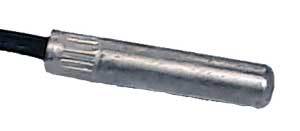
Thermistor Probe For Measuring Ambient Temperature in A Remote Weather Station
This has made the use of analog instrumentation obsolete and has been replaced by digital equipment in the vast majority of remote weather stations.
Durable and accurate thermistors can now be found in most remote weather stations globally. They are not the only type of digital thermometer used in remote stations though...
The Resistance Thermometer Detector (RTD), commonly used in the industrial sector, has found its way into quite a few remote weather stations.
Its robustness and durability make it ideal to be used in harsh environments. A Stevenson Screen is more than big enough to house this instrument, making any size issue irrelevant.
The fact that it can handle a wide temperature range also makes it ideal for use in environments with extreme temperatures. (It is already being used by many meteorological services throughout the world.)
Conclusion
In this article, you did more than just learn about the different types of thermometers used in weather stations. You received a proper overview of thermometers in general and the various industries they are used in.
The focus remained on weather thermometers, though, and by now, you should have a deeper understanding of each weather thermometer, as well as the various mechanisms that make them work.
Never miss out again when another interesting and helpful article is released and stay updated, while also receiving helpful tips & information by simply following this link .
Until next time, keep your eye on the weather!
